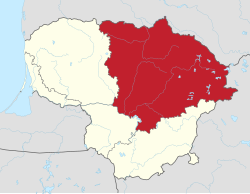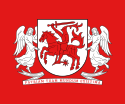Aukštaitija
Aukštaitija | |
|---|---|
| |
| Motto: Patriam tuam mundum existima | |
 Location of Aukštaitija within Lithuania | |
| Country | Lithuania |
| Capital and largest city | Panevėžys |
| Area | |
| • Total | 27,672 km2 (10,684 sq mi) |
| • Excluding Kaunas part | 27,564 km2 (10,643 sq mi) |
| • Kaunas part | 108 km2 (42 sq mi) |
| Population | |
| • Total | 919,212[1] |
| • Excluding Kaunas part | 656,737 |
| • Kaunas part | 262,475 |
| Time zone | UTC2 (CET (GMT +2)) |
Aukštaitija (Lithuanian pronunciation: [ɐukʃˈtɐǐːtʲɪjɐ]; literally Highland or Upland) is the name of one of five ethnographic regions of Lithuania.[2][3] The name comes from the fact that the lands are in the upper basin of the Nemunas, as opposed to the Lowlands that begin from Šiauliai westward. Although Kaunas is surrounded by Aukštaitija, the city itself is not considered to be a part of any ethnographic region in most cases.[4]
Geography
[edit]Aukštaitija is in the northeast part of Lithuania and also encompasses a small part of Latvia and Belarus. The largest city located entirely within this region, Panevėžys, is considered to be the capital, though not in a political sense. Sometimes Utena is regarded as a symbolical capital.
The largest cities by population are:
- Panevėžys – 84,587
- Jonava – 26,423
- Utena – 25,397
- Kėdainiai – 22,677
- Ukmergė – 20,154
- Visaginas – 18,024
- Radviliškis – 15,161
The region has many lakes, mainly on the eastern side.
Subdivisions
[edit]History
[edit]"We do not know on whose merits or guilt such a decision was made, or with what we have offended Your Lordship so much that Your Lordship has deservedly been directed against us, creating hardship for us everywhere. First of all, you made and announced a decision about the land of Samogitia, which is our inheritance and our homeland from the legal succession of the ancestors and elders. We still own it, it is and has always been the same Lithuanian land, because there is one language and the same inhabitants. But since the land of Samogitia is located lower than the land of Lithuania, it is called Samogitia, because in Lithuanian it is called lower land [Žemaitija]. And the Samogitians call Lithuania Aukštaitija, that is, from the Samogitian point of view, a higher land. Also, the people of Samogitia have long called themselves Lithuanians and never Samogitians, and because of such identity (sic), we do not write about Samogitia in our letter, because everything is one: one country and the same inhabitants."
— Vytautas the Great, excerpt from his 11 March 1420 Latin-written letter sent to Sigismund, Holy Roman Emperor, in which he described the core of the Grand Duchy of Lithuania, composed of Žemaitija (lowlands) and Aukštaitija (highlands).[5][6] The term Aukštaitija has been known since the 13th century.[7]
Historically, Aukštaitija corresponded to the Duchy of Lithuania until the 13th century. Its initial capital was most likely Kernavė. In the 1322 treaty of Gediminas, Aukštaitija was called terra Eustoythen (land of Aukštaitians).[8] Some German sources also titled Grand Duke Gediminas, after whom the Gediminids dynasty is named, Rex de Owsteiten (King of Aukštaitija).[9][10] Aukštaitija was mentioned as Austechia in Chronicon terrae Prussiae, written around 1326.[8] Politically, from the end of the 13th century, it comprised the Duchy of Vilnius/Lithuania and the Duchy of Trakai, and it is possible that the term was then used to refer to both of them. Since the 15th century, the Trakai and Vilnius voivodeships made up Aukštaitija, a political and ethnic entity also known as Lithuania proper.
Demographics
[edit]The local people mainly speak the Aukštaitian dialect of Lithuanian. Under the new classification of dialects, Lithuanian is divided into only two dialects, Aukštaitian and Samogitian, with all other varieties now classified as subdialects. The Sudovian and Dzūkian dialects are also considered subdialects of Aukštaitian; the specific subdialect spoken in Aukštaitija is thus known as East Aukštaitian.
The region has Russian and Belarusian minorities in the east. The subdialects spoken there use more loanwords from those languages. However, the usage of dialects in the region, as in Lithuania in general, is declining.
See also
[edit]References
[edit]- ^ "Nuolatinių gyventojų skaičius liepos 1 d.", osp.stat.gov.lt
- ^ "Highlands (Aukštaitija)". Lithuania.travel. Retrieved 10 July 2021.
- ^ "Regions of Lithuania: What to See | True Lithuania". TrueLithuania.com. Retrieved 10 July 2021.
- ^ Lietuvos etnografinių regionų žemėlapis
- ^ Vytautas the Great; Valkūnas, Leonas (translation from Latin). Vytauto laiškai [ Letters of Vytautas the Great ] (PDF) (in Lithuanian). Vilnius University, Institute of Lithuanian Literature and Folklore. p. 6. Retrieved 9 May 2021.
- ^ "Lietuvos etnografiniai regionai – ar pažįstate juos visus?". DELFI (in Lithuanian). Retrieved 9 May 2021.
- ^ "Aukštaitija". Ekgt.lt (in Lithuanian). Etninės kultūros globos taryba (Council for the Protection of Ethnic Culture). Archived from the original on 16 October 2021. Retrieved 9 May 2021.
- ^ a b Zinkevičius, Zigmas. "Etnonimas aukštaičiai amžių bėgyje". Lituanistika.lt. Žiemgalos leidykla. Retrieved 9 May 2021.
- ^ Rowell, Stephen Christopher (1994). Lithuania Ascending: A Pagan Empire Within East-Central Europe, 1295-1345. Cambridge: Cambridge University Press. p. 50. ISBN 978-1-107-65876-9. Retrieved 12 July 2021.
- ^ Baranauskas, Tomas (2006). "Aukštaitija XIII–XV amžiuje". Aukštaičių tapatumo paieškos: Straipsnių rinkinys (in Lithuanian). Kaunas: Žiemgalos leidykla: 32. Retrieved 8 October 2023.







